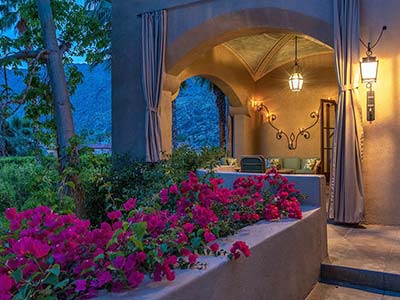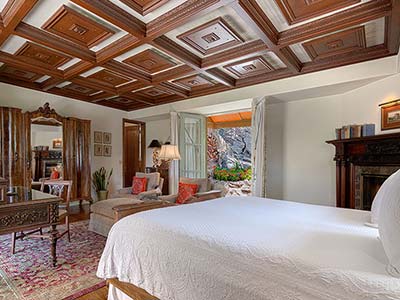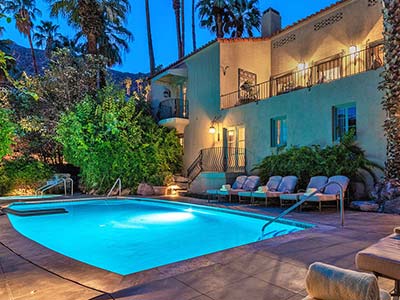The 2018-19 season at the Willows Historic Palm Springs Inn marks a new but familiar milestone in the history of the inn. This year we re-unite the adjacent Mead and Bishop houses into a single estate after some ninety years. The Bishop House was built originally as a fraternal twin to the Mead House, called The Willows. The Bishop offers guests nine new rooms to choose from when booking a stay at the Willows.
The history…
Finished by the summer of 1925, the Bishop House was built with the same blueprints at the William Mead house next door. Roland Bishop was very wealthy; he owned a 30,000 square foot Georgian pile in Holmby Hills. William Mead, Bishop’s best friend and another multi-millionaire from Los Angeles owned an extended estate in Silver Lake. They both sold their mansions and took up residence next to each other in bungalows at the Beverly Hills Hotel.
Bishop made a fortune manufacturing crackers and candies in the early 20th century with his nephew William Bishop. In 1922 the eponymous company had 1000 employees and was producing 15,000 pounds of chocolate daily. It had offices in New York, Los Angeles, Seattle and San Francisco. The company imported cocoa beans from Ecuador and sold products in 24 different countries.
Roland Bishop eschewed publicity and was seldom quoted publically. A profile written by the Los Angeles Times in 1923 remarked that, “Mr. Bishop is the last person whom you could imagine in the candy and cracker business.” The reporter continued, “If I had been asked to character analyze him, I’d have put him in the chair as a president of a small college, or as ambassador, or something dignified like that. But in the candy business? Nay, nay…”
Visiting Nellie Coffman’s Desert Inn, Bishop and Mead became entranced with the desert and engaged William J. Dodd, the architect of the Hearst Examiner Building in Los Angeles, to design them a pair of houses. The plans were individualized enough that the homes would be fraternal rather than identical twins. The Gladding, McBean fountain graced the patio outside the dining room at the Bishop House. The design of the art tiles featured birds and floral motifs. Nestled against mountain boulders, it produced a gentle splash into a teal colored tiled pool.
The Bishop and Mead Houses were originally connected by stone paths when completed in the summer of 1925. Through the following decades they were variously separated, and the connecting pathways obstructed. Over the past year with an extensive restoration project, the homes have been reunited. The properties, including the Gladding, McBean fountain, will be available for public viewing for the first time on January 20th as opened by the Palm Springs Preservation Foundation.
The architecture…
Architect William J. Dodd of the firm of Dodd & Richards exercised the same skill and aesthetic reflected in the Willows to create an equally serene and special home for the Bishops. Unique features of the Bishop House include mahogany beams, original hardwood floors, dramatic mountain views and the Gladding McBean fountain.
The invitation…
Come explore the rooms, the grounds and the special places that make the Bishop House a very special and harmonious addition to a visit to the Willows. As always, we look forward to welcoming you back to a more gracious time and to experience a classic era in the history of Palm Springs. We hope to see you soon. It’s lovely here!




